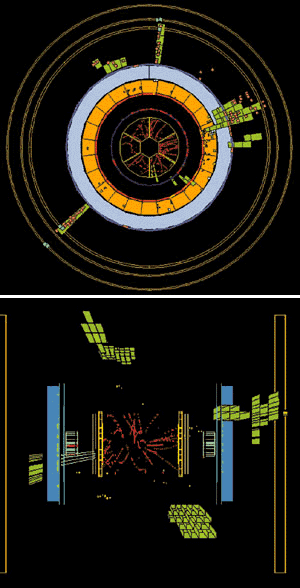After having carefully amassed some 18 million Z particles one by one over 10 years, the experiments at CERN’s LEP electronpositron collider are now producing Zs in pairs.

The Z pairs are the latest addition to a physics gallery that was opened 21 years ago when an experiment using a polarized electron beam at SLAC, Stanford, provided the first firm evidence that nature included a synthesis of weak and electromagnetic interactions.
This landmark experiment succeeded in measuring the delicate interference effects between processes mediated by electromagnetic photons and those mediated by the Z (the electrically neutral carrier of the weak force). Soon after, Abdus Salam, one of the architects of the unified picture, coined the term “electroweak”.
Five years on, at CERN’s protonantiproton collider, the Z came out into the open. In 1989, CERN’s new LEP electronpositron collider and the SLC linear collider at SLAC were being commissioned and the stage was set for a new kind of physics precision studies of the electroweak interaction using Z particles.
At the 1989 LeptonPhoton Symposium at Stanford, SLC physicists reported finding 233 Zs. LEP reported 10 000 Zs in October.
A decade later, this year’s leptonphoton meeting returned to Stanford. Morris Swartz of Johns Hopkins, who reported on precision electroweak physics with Z particles, had 18 million Zs to draw on, amassed, mainly, by the four LEP experiments from 1989 to 1995, before LEP’s energy was increased. The SLC went out in a blaze of glory last year (CERN Courier October 1998) and, with LEP exploring pastures new, these 18 million events will probably remain the bulk of the world’s Z physics archive for some time.
From the Z discovery in 1983 until the advent of LEP and the SLC in 1989, colliders at CERN and Fermilab enjoyed a monopoly on Z physics. This monopoly continued for the W, the electrically charged counterpart of the Z, until 1996, when LEP’s energy was increased sufficiently for experiments to record their first W pairs.
At Stanford this year, David Charlton of Birmingham reported on electroweak physics from LEP2 (LEP operating at or beyond the threshold for producing W pairs). The W mass fix from LEP is 80.35 ± 0.056 GeV, which is now more accurate than the Fermilab Tevatron fix and reflects the shifting focus of W physics. Even greater accuracy is obtained via indirect measurements from the latest round of neutrino experiments at Fermilab.
Using this and other input, electroweak consistency arguments strongly hint that the mass of the Higgs particle, which is responsible for the subtle symmetry-breaking mechanism at the heart of the electroweak mechanism, is lighter than 300 GeV.
At its new energies, LEP is able to probe the interaction of electroweak carriers among themselves, for example via WWZ and WW-photon mechanisms. (A fuller report of LEP2 physics achievements will be published shortly.)
Fermilab’s Tevatron protonantiproton collider still enjoys exclusive coverage of the sixth top quark, which was discovered in 1995. The latest mass fix, reported at Stanford by Mark Lancaster of Berkeley, is centred at 174.3 GeV. Electronpositron machines cannot see the top quark directly, but can infer its presence indirectly. The LEP electroweak consistency fit gives a compatible top quark mass.
After 10 years of precision electroweak physics, the Higgs particle now looms large. However, with LEP’s radiofrequency powerhouse working at full stretch, there is still a chance that LEP could deliver the Higgs before the machine is finally switched off next autumn.








